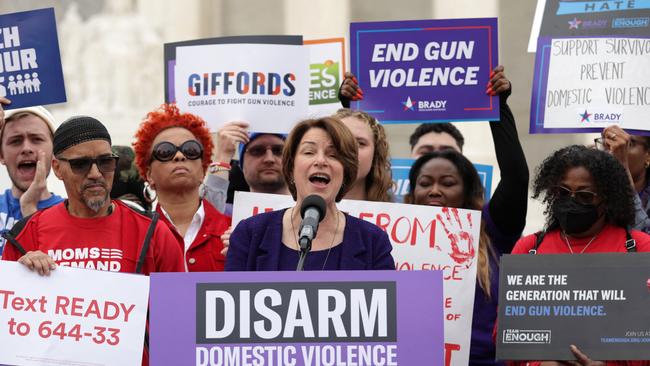US Supreme Court considers whether abusers have gun rights
Supreme Court justices showed little sympathy for a violent domestic abuser arguing he had a right to keep a semiautomatic rifle and a .45 calibre pistol at home.

Supreme Court justices showed little sympathy on Tuesday for a violent domestic abuser arguing he had a Second Amendment right to keep a semiautomatic rifle and a .45 calibre pistol at home, in arguments over the scope of a 2022 precedent holding gun regulations unconstitutional unless they are analogous to those in force in the founding era.
“You don’t have any doubt that your client’s a dangerous person, do you?” Chief Justice John Roberts asked Matthew Wright, a federal public defender representing Zackey Rahimi, who was sentenced to more than six years for violating a federal law prohibiting people under domestic-violence protective orders from possessing firearms.
“I’d want to know what ‘dangerous person’ means,” Wright said. “Well, it means someone who is shooting at people. That’s a good start,” Roberts said.
The Justice Department says the 1994 federal law, and similar measures in some 48 states and territories, help protect vulnerable women, children and bystanders from partners who courts think are dangerous. Although felons can lose their gun rights, the 1994 law is intended to prevent violence before it occurs.
“A woman who lives in a house with a domestic abuser is five times more likely to be murdered if he has access to a gun,” the Biden administration’s lawyer, Solicitor-General Elizabeth Prelogar, told the court. “Domestic violence calls are the most dangerous type of call for a police officer to respond to in this country.”
Criminal defence lawyers, who have seized on the Supreme Court’s more permissive approach to gun rights, have been challenging such measures as far more restrictive than the framers would have found permissible. Along with gun groups and conservative organisations, several public defender agencies filed briefs backing Rahimi’s position.
The expedited procedures that family courts use in issuing domestic violence orders are too flimsy to justify abridging an individual’s gun rights, Wright said. Congress “made a one-sided proceeding that is short a complete proxy for a total denial of a fundamental and individual constitutional right,” he said.
A family court in Fort Worth, Texas, issued a protective order against Rahimi after he pulled a gun on his ex-girlfriend in a parking lot and shot at a witness who saw them arguing. According to authorities, he flouted the order, continuing to threaten people with guns, fire in the air when children were present and shoot an AR-15 into the home of one of his narcotics customers.
But Rahimi’s conviction under the federal law was tossed out earlier this year by the Fifth US Circuit Court of Appeals, in New Orleans, which said the 1994 measure had no analogue to ordinances known in 1791, when the Second Amendment was ratified. Under last year’s precedent, New York State Rifle & Pistol Association v. Bruen, the Fifth Circuit found the 1994 law was unconstitutional because the founding generation didn’t respond to domestic violence by disarming abusive spouses or partners.
Rahimi’s case offered the Biden administration a chance to argue that such expansive readings of Bruen, which lower courts have used to throw out laws including the prohibition on possessing weapons with obliterated serial numbers, go well beyond what the Supreme Court had in mind.
“It’s important for the court to understand the destabilising consequences of that profound misreading,” Prelogar told the court. Federal judges have thrown out weapons charges against “armed career criminals who have multiple convictions for aggravated assault, drug trafficking, armed robbery — clearly violent crimes — because we don’t have a sufficient historical analogue (to) precisely those crimes at the founding,” she said.
Liberal justices, who vehemently dissented from Justice Clarence Thomas’s Bruen opinion, used Tuesday’s argument to suggest ways to limit its impact.
Justice Ketanji Brown Jackson cited last month’s mass shooting in Lewiston, Maine, where a gunman killed 18 people at a bowling alley and bar before taking his own life. How would a state legislator drafting laws to reduce the chances of similar massacres ensure her bill was constitutional, she asked.
“Do you read Bruen as, Step One, being, Go to the archives and try to determine whether or not there’s some historical analog for the kinds of legislation I’m considering?” Jackson asked.
Prelogar said Bruen required studying history and tradition to locate the legal principle behind founding era ordinances, a more general standard than seeking precise antecedents in the 18th century for legislation today.
The government argues that throughout English, colonial and American history, lawmakers have adopted measures disarming criminals and people judged too irresponsible to possess weapons — a group that in times past included drunkards and vagrants, and today focuses on the mentally ill.
Conservative justices, who view the Bruen case as a victory for their method of constitutional interpretation as much as they do its significance for gun rights, sought to draw a line between disarming people like Rahimi, who now is jailed on aggravated assault charges, and giving lawmakers too much leeway to regulate weapons.
Justice Neil Gorsuch suggested that the issue wasn’t the constitutionality of disarming domestic abusers, but rather whether procedures state law provides for issuing protective orders were fair and gave defendants an adequate opportunity to present their side.
Taking that approach could uphold the 1994 law in general, but allow individuals to contest losing their gun rights on the grounds the family court hearings in specific states violated their due-process rights.
A decision in the case, US v. Rahimi, is expected before July.
The Wall Street Journal



To join the conversation, please log in. Don't have an account? Register
Join the conversation, you are commenting as Logout